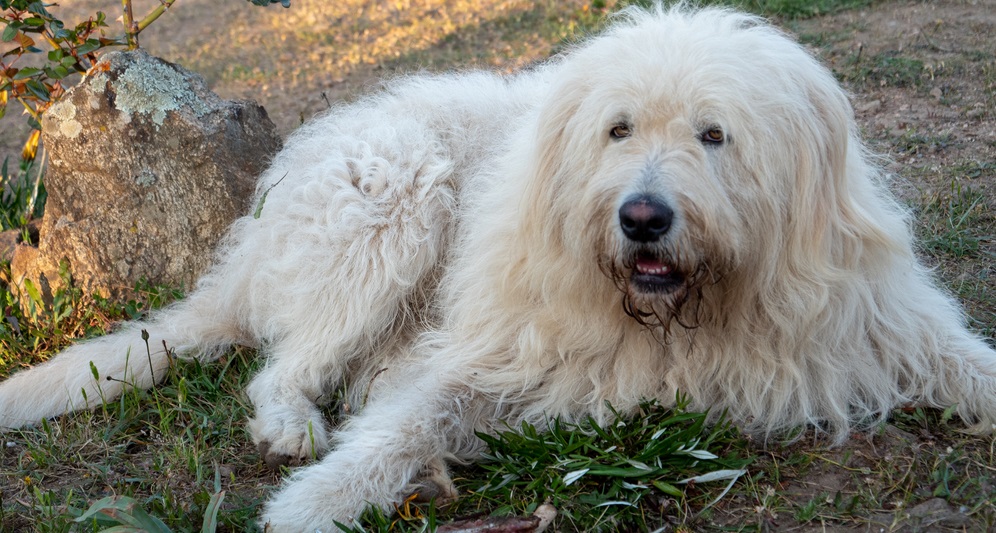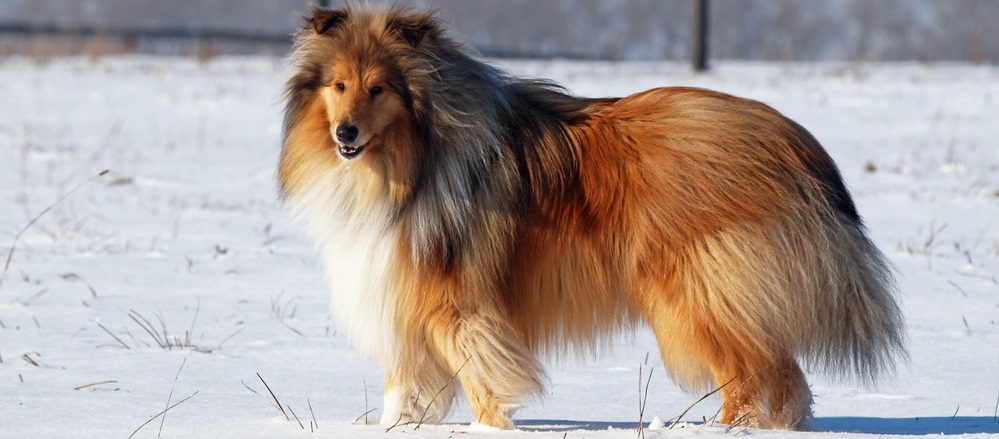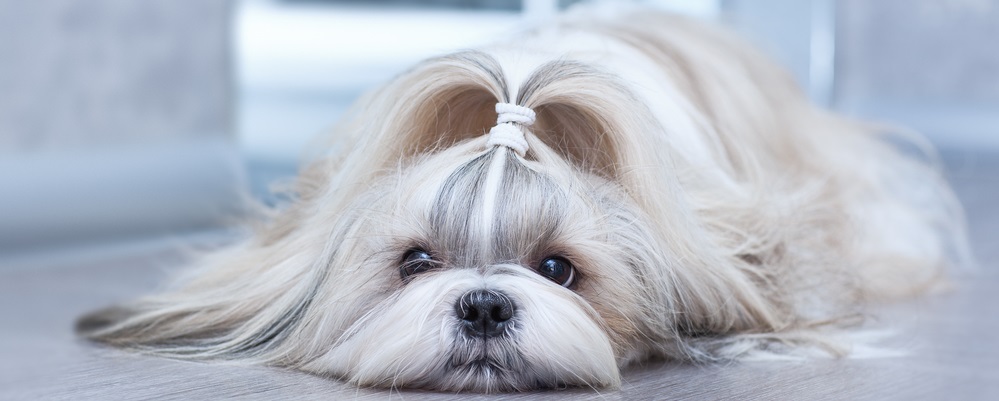As a dog owner, you probably know the feeling of running your hands through your dog’s normally luscious fur only to be stopped by something strange—a scratchy patch of knotted hair that won’t come out with gentle finger-combing. These are called mats.
Fur mats are large chunks of hair that seem to have tangled past the point of no return. You may have even experienced mats yourself if you’re a particularly tumultuous sleeper or if you’ve had to endure a long period outside of your normal grooming routine. If you’re currently dealing with matted dog hair, don’t worry. Mats are common in dogs, and thankfully, they’re also treatable and preventable with the right awareness and care.
Wondering how to get mats out of dog hair? Read on to discover the best ways to remove mats from your dog’s hair, as well as to learn what causes mats and how to prevent them in the first place.
What Causes Mats in Dog Hair?
Fur mats come in all shapes and sizes. They can be as small as a coin or large enough to encompass the dog’s coat (in extreme cases). In fact, mats are often a part of life for dog owners. But how do these seemingly insurmountable tangles happen in the first place?
Of course, to have matted hair, your dog needs to have a coat to begin with. That’s why mats are more common in dogs with long, woolly, or curly fur—particularly the Poodle, Doodle, Curly coat, Cocker Spaniel, Bishon, or ShihTzu. But even short-haired pups can experience mats.
This is because, aside from coat length, other factors impact the development of mats, including:
- Friction – Anything that’s in constant contact with your dog can cause friction, which can, in turn, cause mats. This is because anything in constant contact with your dog can rub their fur until it’s tangled into a mat. The most common examples of this are wearable items like collars, harnesses, dog clothes, and even dog shoes. To keep your dog mat-free (but still looking cute in their holiday sweater), make sure these types of wearable accessories fit comfortably and don’t move around too much. It’s also helpful to remove and wash these items frequently to prevent matting and keep your pet feeling fresh.
- Scratching – If you see matting primarily around the ears, sides, or wherever else your dog may scratch and lick excessively, the cause may be common itch-inducing culprits: fleas and allergens. Take your dog to the vet if you suspect allergies, and make sure your dog is getting the flea treatment they need to prevent pesky flea infestations.
- Shedding – Ever seen a Newfoundland or Malamute shed in the spring? It’s like they’re being followed around by little white clouds or trailing soap suds behind them. A few times a year, certain dogs shed their undercoat to prepare their fur for the coming warmer months. In these instances, shed fur can mix in with attached fur to form a tangled, matted mess.
If you’ve been wondering how to stop a dog from shedding, it’s usually normal. Instead of trying to prevent shedding, just make sure to frequently brush your dog to prevent shed fur from tangling with attached fur.
- Water – You may already be familiar with mats if your dog loves running outside in the rain, swimming, or rubbing their belly in the wet grass. Why? Water can actually create tangles in the fur. Combined with dirt, dust, or mud, the water can cement your pup’s hair into a seemingly impenetrable mat. So after a day at the lake, a dip in the pool, or even bathtime, be sure to properly dry and brush out your dog’s hair. Otherwise, you may end up with tight, tangled mats.
How to Remove Mats from Your Dog’s Hair
Even the best cared for coats can get matted and tangled from time to time. So what’s the best way to detangle fur and get rid of stubborn mats?
A few preparatory steps can make it so much easier to get mats out of your dog’s hair. To simplify the process, do the following before even breaking out the combs:
- Bathe your dog with a high-quality shampoo. Even if their fur is matted, a quick shampoo can remove at least some of the dirt caked into your pup’s coat.
- Let your pup out for a potty break immediately after their bath. Often, mat removal can take a while, and you want them to be as comfortable as possible throughout the entire process.
- Dry your pup’s hair (especially the mat) completely with a towel, and then with a blow dryer on a low heat setting. Because mats naturally trap moisture, it helps to dry out the mat completely before you get to work on it. Starting the detangling and removal process with dried fur makes the process significantly easier. A teaspoon of cornstarch is also a puppy-safe drying agent you can use before you start dematting.
After completing your prep steps, grab a comb that works best for your dog’s coat type. If you’re not sure what kind of comb works best, consult with your vet.
You may also want to take advantage of certain mat removal tools. For instance:
- A mat breaker – If the mat is large, a mat breaker may help split up the mat so you can work on individual pieces. A mat breaker is a tool that resembles a comb with nine claw-like teeth. It’s designed to reach under the mats and pull them up and out. Just make sure you don’t pull through too much—instead of breaking up the mat, you could pluck out your dog’s fur.
- A slicker brush – A slicker brush can be useful in basic detangling once the mat is small enough. Slicker brushes have hard wire bristles with bent ends. These ends may be sharp, so make sure your hand is securely beneath the mat when you brush it out to protect your pup’s sensitive skin.
Once you have the proper mat removal tools, follow these steps for a smooth dematting operation:
- Hold the mat firmly – Whenever handling a mat in your dog’s fur, make sure you pinch the base of the mat with your fingers and keep your hand against your dog’s skin. That way, your hand acts as a barrier between the mat and the sensitive skin beneath. Any brushing or detangling will only graze your hand.
- Pull the mat away from the skin – Once you have the mat in hand, pull it as far away from your pup’s skin as you can without causing them discomfort. This will relieve the tension on the hair follicles, making the experience more comfortable and keeping hair from falling out unnecessarily.
- Start at the bottom – It’s best to start the detangling process from the bottom. Then, slowly comb out the tangles. Depending on the size and severity of the mats, this process could take anywhere from a few minutes to a few hours.
- Take breaks (and provide treats) – Throughout the procedure, make sure to take breaks to give your dog treats and ensure they don’t become anxious during the process. As stated earlier, detangling mats can take some time, so the trick is patience, not speed.
- Recombine the hair – Once the mat is nearly detangled, a pin brush, with its densely-packed bristles, will help the hair recombine with the rest of the coat. You can finish off the entire process with a steel comb. Begin with the wide-toothed end and work your way to the finer teeth to make sure all the tangles are gone.
The dog grooming process of untangling matted fur can be long and arduous. If you are worried about making things worse, you can always hire a professional dog groomer. They have more experience and knowledge in dealing with a matted coat. The professional groomer can also recommend which grooming products and tools are more appropriate for which breed.
What Not To Do During Mat Removal
When removing mats from your dog’s fur, there are a few maneuvers you want to be sure to avoid. These include:
- Do not cut the mat out with scissors or a grooming tool. Not only can this cause a non-uniform coat, but it’s extremely easy to accidentally cut your dog’s tender skin—especially if they suddenly jump out of nervousness or excitement.
- Don’t take risks when there’s matting around your dog’s ears. Ear skin is thin, delicate, and full of blood vessels. Instead of trying to brush mats out on the ears, opt for shaving them from the get-go.
- Do not attempt to remove the mats yourself if your dog has “pelting.” Pelting occurs when your dog’s undercoat is completely matted together, and you cannot reach the skin when brushing. This case requires a vet or groomer to carefully shave off the fur with clippers.
Shaving Your Dog’s Fur: A Last Resort
Detangling mats requires patience, but sometimes, completely detangling a mat isn’t feasible. If your efforts appear to be fruitless, if your dog simply can’t withstand the process, or if there’s too much matting, brushing out the mats isn’t going to be your best option.
Instead, you may need to shave part, or all, of your pup’s fur. But shaving your dog isn’t the easy way out (which is why it should be left as a last resort). In fact, shaving some or all of your dog’s hair is another process that requires patience, a gentle touch, and the proper tools, especially because the skin below the fur is so sensitive and delicate.
The best dog clippers for matted hair should be heavy-duty clippers that can handle the mats quickly and easily without overheating. Low to medium speed clippers are preferred for such a thorough job. However, depending on the number of mats in your dog’s hair, your best bet may be to visit your local groomer and let the professionals take the wheel.
How to Prevent Mats
The best way to handle mats is to avoid them altogether. Wondering how to care for dog hair to prevent mats from developing in the first place? Essentially, mats can be prevented with a combo of lifestyle and dietary choices.
Brushing and Grooming
While you should remain alert to the common causes of matted fur (friction from collars and other accessories, shedding complications, and water saturation), frequent grooming is essential to preventing future mats in your pup’s fur. And grooming your dog isn’t just beneficial in preventing mats. It also cuts down on shedding, massages the skin, brings healthy oils to the surface, and makes your pup’s coat glossy, shiny, and tangle-free.
You can brush your dog once or several times a day, depending on their preference. This part of their grooming routine should be like a mini-massage—relaxing, calming, and soothing. Plus, it can serve as a special bonding experience between you and your furry friend.
To effectively prevent mats and make the most out of your brush time, make sure you’re using the best type of brush for your dog’s coat:
- Long-haired and curly dogs need something that dives through their fur and gently divides. We recommend using slicker brushes or pin brushes for this type of coat.
- Medium to short-haired dogs can benefit from curry combs and soft bristle brushes.
When brushing, gently move the brush from nose to tail, making sure to include the legs, ears, and everything in between. You can also use a detangler spray to make brushing go smoother (especially if your dog is active and has easily tangled fur), as well as undercoat rakes to get at that excessive springtime shedding before it happens.
Proper dog coat maintenance doesn’t stop at brushing. Haircuts are also an important aspect of your dog’s grooming. To reduce the likelihood of mats, it’s best to trim your dog’s hair every 4 to 6 weeks. This will help keep the length manageable and the mats to a minimum.
Bathing
Frequent bathing is essential to mat prevention. While you should avoid bathing your dog if they already have mats (since water can worsen the mats), regular bathing washes away any excess hair that brushing didn’t catch.
The perfect bath starts with Vetericyn FoamCare® Pet Shampoo. Vetericyn’s pH-balanced formula is spray-on and instantly foaming, making bathtime faster and more fun.
Vetericyn offers three formulas: FoamCare® Pet Shampoo for all coats, FoamCare® Pet Shampoo for thick coats, and FoamCare® Medicated Pet Shampoo for extra sensitive skin or pups with dermatological conditions. Whatever your dog’s needs are, they deserve a gentle, nourishing wash and a gorgeous coat.
Diet
If you’ve been wondering, why is my dog losing hair, even with mats, look into their diet! To keep your dog’s hair follicles strong, you need to make sure you’re feeding them a diet full of essential nutrients. For hair follicle health, opt for meals that are high in:
- Protein
- Fats
- Omega-3s
In addition, providing your dog with daily supplements can ensure they’re actually getting and absorbing all the nutrients their body needs. Supplements made with natural ingredients and packed with the vitamins and minerals your dog needs for a healthy coat can keep your dog looking and feeling their best.
Need a supplement suggestion? Vetericyn’s ALL-IN comes in three formulas perfect for your dog at every stage of their life. Plus, it’s packed with prebiotics and antioxidants to promote gut and immune system health. And as a bonus: if you’ve been wondering how to make a dog’s coat shiny, look no further. You can trust ALL-IN to deliver a glossy, healthy coat and a happy, healthy dog.
Why Preventing and Treating Mats is So Important
Whatever the underlying cause, tangled fur should be taken care of as soon as possible. If left alone, the mats will only get bigger and harder to remove with time. While small mats are nuisances, large mats can be extremely painful to your dog.
The knotted hair pulls together, blocking oxygen and trapping moisture. When not untangled, matting can result in irritation and skin sores. More extreme cases of matted fur can even:
- Lead to hematomas
- Cut off circulation
- Mask more severe conditions, like parasites
Live Mat-Free with Vetericyn
Mats happen. Every dog that loves to swim, roll in the wet grass, or show off their gorgeous fur (so essentially, any dog) will likely experience mats at some point in their life. So there’s no shame if you feel that unruly little lump in your puppy’s fur. It’s just another part of dog life that needs taking care of. And luckily, you have Vetericyn on your side to help.
Whether you’re trying to prevent mats from happening or have had a few tangled run-ins already, Vetericyn has you covered. Our products will provide your dog with a strong, healthy coat from the inside out.
Sources:
- ASPCA. A Haircut Could Save a Life: Preventing Your Pet’s Coat from Matting. https://www.aspca.org/news/haircut-could-save-life-preventing-your-pets-coat-matting
- VCA Animal Hospitals. Grooming and Coat Care for Your Dog. https://vcahospitals.com/know-your-pet/grooming-and-coat-care-for-your-dog
- Wag! How to Prevent Your Dog’s Hair From Matting. https://wagwalking.com/wellness/how-to-prevent-your-dogs-hair-from-matting
- Andrea Arden. How to Remove Mats From Your Dog’s Coat. https://andreaarden.com/dog-health/how-to-remove-mats-from-your-dogs-coat/
- WoofGang Bakery & Grooming. What Your Groomer Wants You to Know About Matting. https://woofgangflemingisland.com/blog/what-your-groomer-wants-you-to-know-about-matting/
- The Spruce Pets. Dealing With a Shedding Dog. https://www.thesprucepets.com/reduce-dog-shedding-1118286#:~:text=This%20process%20is%20sometimes%20called,thicker%2C%20warmer%20coats%20for%20winter.
- Breeding Business. 7 Best Clippers for Matted Dogs. https://breedingbusiness.com/best-clippers-for-matted-dogs/


